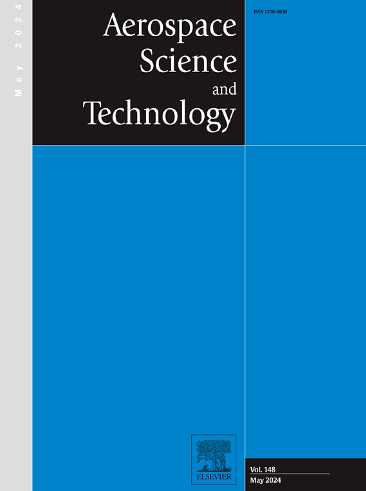Aerothermal performance of different relative positions of holes and ribs of a flat-plate film cooling hole with a straight-ribbed crossflow coolant channel
IF 5
1区 工程技术
Q1 ENGINEERING, AEROSPACE
引用次数: 0
Abstract
The integration of internally ribbed cooling channels with external film cooling is a widely adopted cooling technique for gas turbines. This study numerically investigated the effects of different relative positions of holes/ribs on the flow and heat transfer characteristics of cylindrical film-cooling holes. Nine film-cooling hole position cases, two crossflow Reynolds numbers (Re = 200,000−600,000), and four blowing ratios (M = 0.5 − 2.0) were considered. All cases used the ribbed crossflow supply method with a rib height of 0.4 D. We analyzed the change rule in the cooling performance and discharge coefficients with the relative positions of holes/ribs. In addition, we analyzed the mechanism contributing to relevant changes from the perspectives of the structure of the flow field inside and outside the holes, as well as the aerodynamic and heat transfer characteristics. The relative positions of the holes/ribs exerted a more pronounced impact at high crossflow Reynolds numbers. Across the entire range of operating conditions, positions 6 and 9 demonstrated the highest film-cooling performance and discharge coefficient, respectively. When the crossflow Reynolds number was relatively high and the blowing ratio was 1.0, the difference in the film-cooling efficiency between positions 6 and 8 was 45.9 %, which increased to 88.1 % at a blowing ratio of 2.0. Hence, the relative positions of film-cooling holes affect the degree to which the holes are affected by the crossflow, which consequently affects the flow-field structure and aerothermal properties. This research aids in achieving refinement and integration in the design of turbine blade cooling structures.
求助全文
约1分钟内获得全文
求助全文
来源期刊

Aerospace Science and Technology
工程技术-工程:宇航
CiteScore
10.30
自引率
28.60%
发文量
654
审稿时长
54 days
期刊介绍:
Aerospace Science and Technology publishes articles of outstanding scientific quality. Each article is reviewed by two referees. The journal welcomes papers from a wide range of countries. This journal publishes original papers, review articles and short communications related to all fields of aerospace research, fundamental and applied, potential applications of which are clearly related to:
• The design and the manufacture of aircraft, helicopters, missiles, launchers and satellites
• The control of their environment
• The study of various systems they are involved in, as supports or as targets.
Authors are invited to submit papers on new advances in the following topics to aerospace applications:
• Fluid dynamics
• Energetics and propulsion
• Materials and structures
• Flight mechanics
• Navigation, guidance and control
• Acoustics
• Optics
• Electromagnetism and radar
• Signal and image processing
• Information processing
• Data fusion
• Decision aid
• Human behaviour
• Robotics and intelligent systems
• Complex system engineering.
Etc.
 求助内容:
求助内容: 应助结果提醒方式:
应助结果提醒方式:


